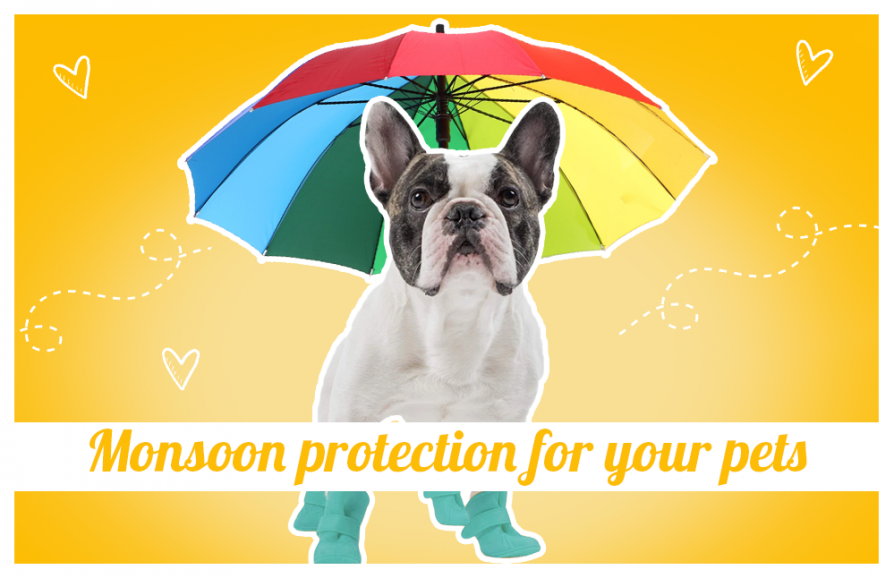Protecting Your Pet Against Monsoon Illnesses
- August 1st 2020

It’s that time of year again! The monsoon is here and, with it, a whole host of diseases your pet can catch. We know, we know – COVID-19 has pretty much exhausted your capability to hear about more diseases you need to guard against. But while our saturation levels may be at an all-time high, your pet’s immunity is low and monsoon diseases won’t disappear simply because you don’t want to look at them.
So
here’s what you need to look out for this season. The good news? The constant
lockdowns mean your pet won’t be outdoors too much, so the chances of them
catching these illnesses is lower. Still, it’s always best to be vigilant.
Leptospirosis
Leptospirosis
is one of the most dangerous diseases your dog can contract during the rainy
season. It is an infection caused by
Leptospira interrogans, commonly known as Leptospires, which enter
your dog’s system through wounds or ingestion and spread through the
bloodstream. The disease affects the liver, kidneys, central nervous system and
more.
Leptospires thrive during the rainy season,
in muddy or marshy areas, and dogs can contract the disease through contact
with infected water or mud. Leptospirosis also spreads through contact with the
urine of infected animals, mostly rats. It is a dangerous disease for both animals
and humans, and you should get in touch with your vet immediately if you
suspect your dog is infected.
Symptoms and prevention: Leptospirosis causes fever, vomiting, sudden diarrhoea, depression
and coughing in dogs, among other symptoms. Treatment includes antibiotics
usually, and hospitalisation if your dog is severely infected (but this is
rare). Prevention is best, of course, and you should be careful when taking
your dog out for a walk. Always make sure that any cuts or wounds that your dog
may have are not exposed to the air or mud, and keep your canine away from
drinking puddle water. Vaccination is another great way to ensure your dog is
protected against the disease this season.
Gastroenteritis
Gastroenteritis
refers to an inflammation of the stomach lining and the intestines. It is more
common during the rainy season and can range from a mildly upset stomach to
more severe cases. It usually results in vomiting and diarrhoea, and symptoms
include loss of appetite, depression and lethargy.
Causes and prevention: Gastroenteritis spreads through many channels. Your dog could get
it through parasites or by ingesting something toxic, or through different
diseases. It’s always best to take your pet to the vet to diagnose the exact
cause of the problem and how to treat it. Prevention usually involves
monitoring what your dog eats (especially when they’re out on walks), and
making sure their vaccinations are up to date.
Worm infections
Worm
infections generally refer to parasites that affect your dog’s intestines, the
most common of which are roundworms and tapeworms. Worm infections are tricky,
as some of them have symptoms – your dog starts losing their fur and then their
appetite, they start vomiting and losing weight – but some infections don’t
have any symptoms at all and your dog can have a worm in their intestines for a
long time before you notice. Roundworms can usually be spotted in your dog’s
stool but hookworms are so small that they are impossible to spot.
Treatment and prevention: If you suspect your dog has worms, it’s best to get a stool sample
tested at the vet’s clinic. Prevention would include deworming your dog at
regular intervals and especially before the monsoon, when the incidence of worm
infections is higher.
Skin diseases
The
damp weather this season is not great for your pet and it’s important to make
sure they are always dry. Wet fur can lead to skin diseases, which can develop
into infections if your dog scratches too much and creates a wound. Skin
infections can usually be spotted if the skin is red or swollen or if there is
a rash, but the clearest sign is always the most obvious – your dog is
scratching or licking themselves too much.
Prevention: Keeping your pet dry is crucial. Always remember to bathe them this
monsoon but make sure you blow-dry their fur properly. Take special care of your
dog’s problem areas, such as the paws and ears (especially for dog breeds with
long and floppy ears) as these do not dry very easily. Dry shampoos are also an
excellent option in this weather. Keep checking their skin to make sure no
rashes appear – and treat them to a
spa day every once and a while!
Water-borne diseases
Your
dog may love puddles but they can be your worst enemy. Water-borne diseases are
one of the most dangerous threats this monsoon, and it’s important for you to
steer your pup clear of dirty or stagnant water. Keep a good eye on them during
walks to make sure they’re not drinking everything in sight. And keep changing
their water bowl at home, so that the water they’re drinking is always fresh
and clean.
Ticks
Ah,
ticks. This is a common affliction, but it does tend to get more problematic
during the rainy season. Prevention is always best with it comes to ticks, so
make sure you clean your pet’s bedding often and keep the house tick-free.
There are also devices you can attach to your dog’s collar to keep away fleas,
such as the
TicklessCream Coloured Anti-Flea Collar Device , which works by emitting
ultrasonic pulses that keep away fleas. And the old staple always comes in
handy –
anti-fleaand tick shampoos and powders.
Pet care in the monsoon may take a little extra effort than usual, but there’s no reason why your beloved dog cannot enjoy the rains as much as we do. Armed with the knowledge and the list of preventive tips in this article, you should be well on your way to tackling the monsoon and all its perils.
Comments
No posts found
